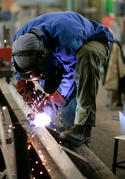The troubles of Detroit are well-publicized. Its economy is in free fall, people are streaming for the exits, it has the worst racial polarization and city-suburb divide in America, its government is feckless and corrupt (though I should hasten to add that new Mayor Bing seems like a basically good guy and we ought to give him a chance), and its civic boosters, even ones that are extremely knowledgeable, refuse to acknowledge the depth of the problems, instead ginning up stats and anecdotes to prove all is not so bad. read more »
Newgeography.com - Economic, demographic, and political commentary about places
Getting Real About “Green” Jobs
Over the past year, Economic Modeling Specialists, Inc. (EMSI) has been fielding questions from local planners (workforce boards, community colleges, and economic developers) on how to look at green jobs, particularly at the regional level. Perhaps nothing has been more hyped, or misunderstood, than the potential impact of this sector on local economies.
In order to wade through the rhetoric and often overblown expectations, we’ve been doing our best to link labor market data to potential green sectors so people can gain an understanding of trends, earnings, education levels, and skills associated with “green occupation clusters”. So far, we have made three general observations: read more »
Numbers Don't Support Migration Exodus to "Cool Cities"
For the past decade a large coterie of pundits, prognosticators and their media camp followers have insisted that growth in America would be concentrated in places hip and cool, largely the bluish regions of the country.
Since the onset of the recession, which has hit many once-thriving Sun Belt hot spots, this chorus has grown bolder. The Wall Street Journal, for example, recently identified the "Next Youth-Magnet Cities" as drawn from the old "hip and cool" collection of yore: Seattle, Portland, Washington, New York and Austin, Texas. read more »
Housing Design: Create The Next Classic
I often compare home marketing to automotive marketing, not because I was raised in Detroit and am somewhat of a motor head, but because these are two very big ticket items that have been developed and marketed in very different ways. You may think that auto companies are huge corporate conglomerates, and builders are mostly small, local companies selling a home or two, but the major builders certainly are not small concerns. A major builder selling 50,000 homes at $250,000 each would generate the same total income as a small auto company selling 500,000 cars at $25,000 each. read more »
- Login to post comments
Lost City
We agreed, last time, to meet at the corner of Yonge & Bloor – Toronto's busiest subway stop. read more »
GOP Needs Economic Populism
You would think, given the massive dissatisfaction with an economy that guarantees mega-bonuses for the rich and continued high unemployment, that the GOP would smell an opportunity. In my travels around the country — including in midstream places like suburban Kansas City and Kentucky — few, including Democrats, express any faith in the president’s basic economic strategy. read more »
Healthcare Reform or Health Insurance Bailout?
What is the real endgame of healthcare debate in Washington? Is it going to be a bailout of the insurance industry as opposed to a plan to provide healthcare for every American? The original jumping off point for this entire debate was that the United States is the only major industrialized country that does not have a national healthcare system. The debate has moved away from “how do you get healthcare” to “how do you get health insurance.” read more »
Yes, Manufacturing Matters
Manufacturing employment has fallen below 12 million jobs for the first time since 1941, and manufacturing jobs as a percentage of total employment has fallen below 9%, the lowest level since the Bureau of Labor Statistics started collecting data in 1939. But annual manufacturing output per worker is also at a record high: $223,915 (in constant 2000 dollars). That's almost 3 times as much output per worker as in the early 1970s, and twice as much output per worker compared to the mid-1980s.
That has been the trend over the last 40 years: more output with fewer workers. That’s a good thing, or inevitable, or both – isn’t it? I used to think so; now I’m not so sure. read more »
Report from Orlando: The Spirit Rocks On
By Richard Reep
“In hard times, people turn to God or alcohol” jokes Bud Johnson of Constructwire, a database that tracks planning and construction projects nationwide. Johnson, 50, is an industry veteran and has never seen a recession like this in his career. “This is an exceptionally broad-based downturn,” he says, “and Orlando has been hit harder than most in the South, what with your only real industries being housing and tourism.” Both industries have been trapped like mammoths in a glacier as the credit market stays stubbornly frozen in a modern banking Ice Age. read more »
- Login to post comments
Let Freedom Ring: Democracy and Prosperity are Inextricably Linked
With autocratic states like China and Russia looking poised for economic recovery, it's often hard to make the case for ideals such as democracy and rule of law. To some, like Martin Jacques, author of When China Rules, autocrats seem destined to rule the world economy. read more »






















